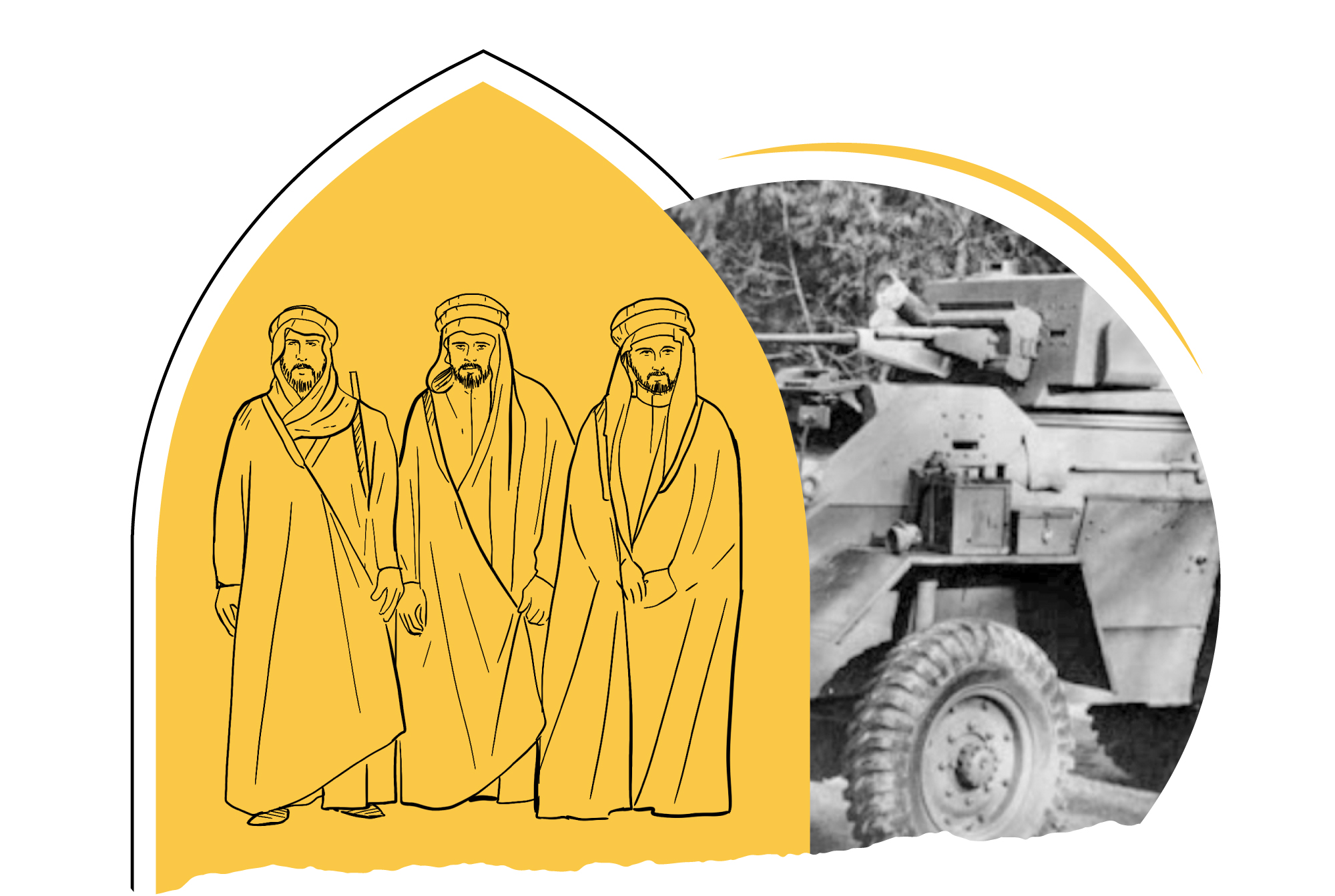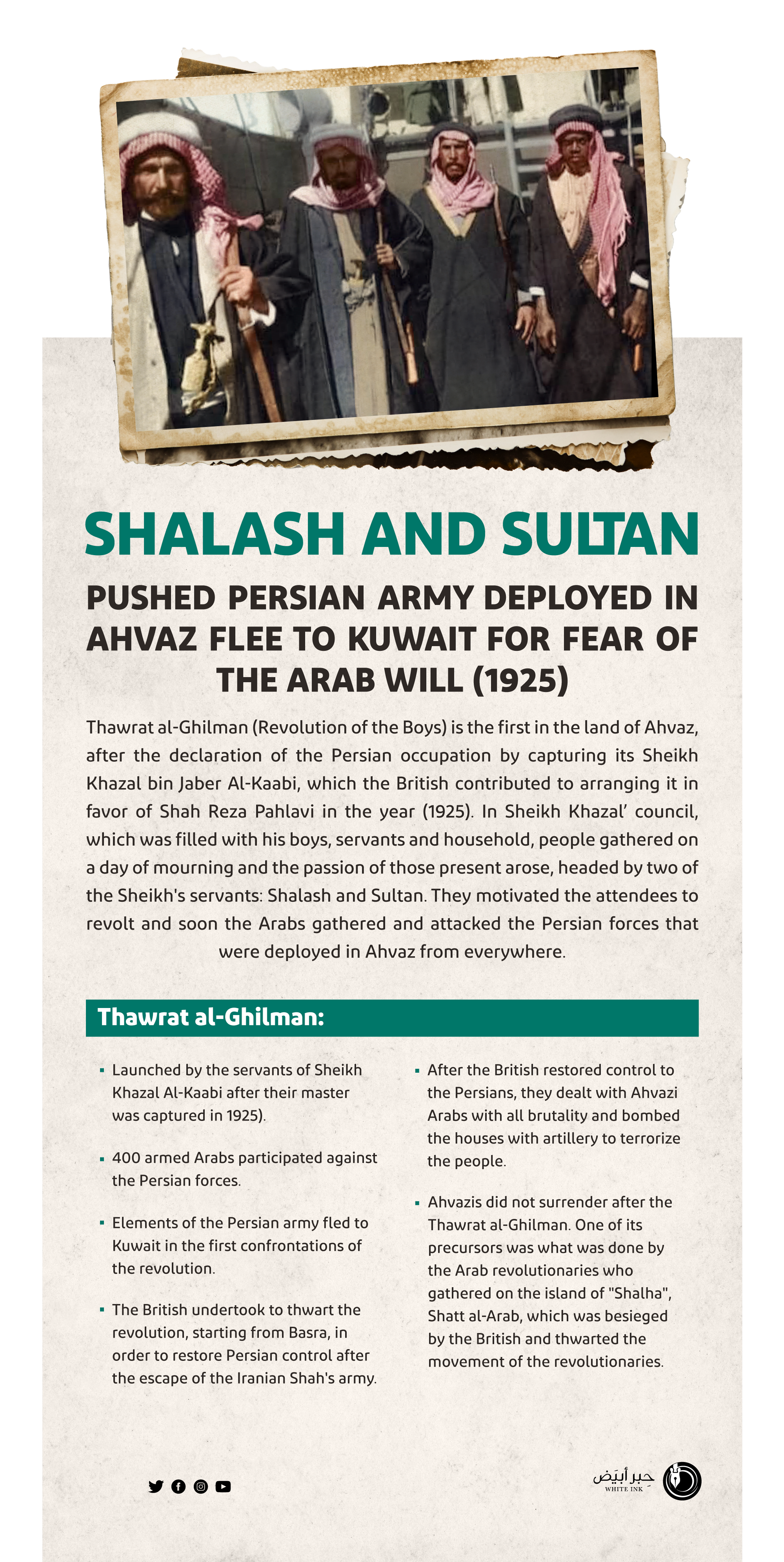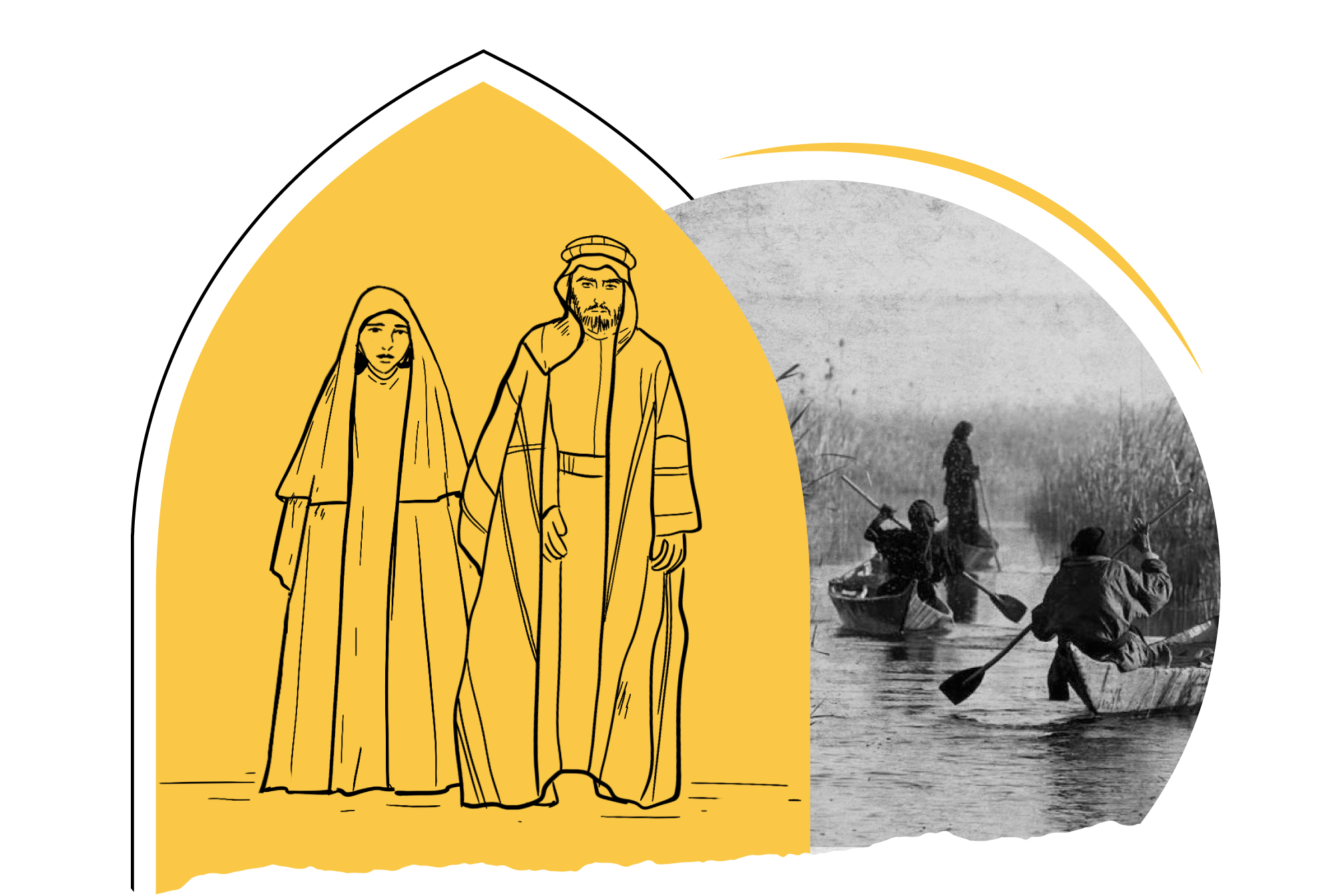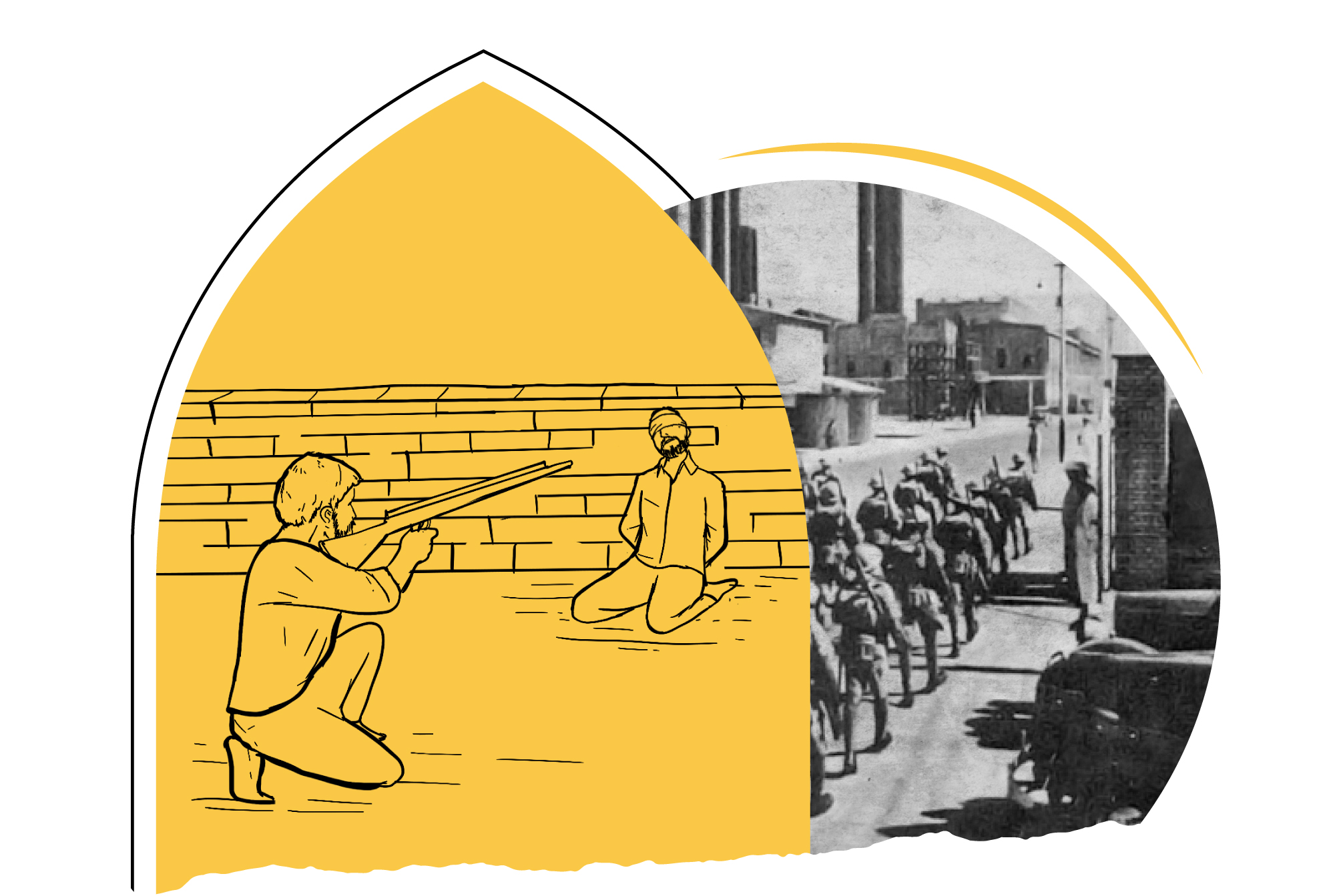
Thawrat al-Ghiman (1925)
Launched from Sheikh Khazal's "Palace" and Almost Ended the Persian Presence
It never occurred to the Iranian government that there would be strong and expected reactions from Ahvazi Arabs. Iran led the Prince of Ahvaz, through a malicious plot with its godmother, Great Britain, which secretly planned to occupy the Persians of Ahvaz, first to serve its colonial interests and then to prevent the Russians from reaching the Arabian Gulf and strengthen Iran’s influence in the Arab region, so that the Arabs would not be the only ones to take over the region’s oil sources and control over the key trade routes across the Arabian Gulf.
Ahvaz resistance began only three months after the occupation of Ahvaz, which was on 20 April 1925, when Sheikh Khazal’s soldiers and his private guards stood up against the Persianization policy and launched a revolution known as “Thawrat al-Ghilman” (Boys’ Revolution) on 22 July, under the leadership of the two boys (Shalash and Sultan). It was their response to the captivity of their Arab Sheikh and Emirate. The British report refers to that revolution stating that: “The Arab uprising broke out in Muhammarah at about seven thirty in the evening of the twenty fourth of July 1925. It was serious uprising of Arab tribesmen in Muhammarah, where about 400 armed Arabs, most of whom were boy servants of the sheikh of Muhammarah city, the Persian garrison, occupied the city by midnight”. In that revolt, members of the Iranian army fled to Kuwait and rebels took control of Muhammarah for several days. However, the British, according to what was stated in their report:
“Having lost contact with the British Vice-Consul, Sir A.T., the General Manager of the Anglo-Persian Oil Company, Wilson, took over and radioed the Chief Naval Officer in the Persian Gulf to urgently dispatch a gunboat and another to Basra, along with Humber Mk 3 Armoured Car, which arrived Basra at 01.00 am. On the morning of 25 July, it stood at the outer anchorage of Karun River.
British intervention saved the Persians before Sheikh Khazal's ghilman’s movement finished them off.

They sent armored cars and soldiers in support and backup operations from Basra. However, the first were returned before they reached the border and the last one did not land because the situation improved before their arrival. With the help of reinforcements from Ahvaz, the Persian forces reoccupied it on the morning of the 25th of August and pushed the Arabs towards Al-Faili. It was reported that the Arabs lost about 130 persons and Persian forces reoccupied the city on the morning of the 25th. The city was completely plundered and two employees of the Anglo-Persian Oil Company were wounded, where one of them, a British Indian citizen, later passed away.”
Then the Iranian army’s artillery bombarded them mercilessly after destroying the Persian garrison in the city. Following the failure of this Ahvazi resistance and its uprising against the occupation, severe terror descended on Ahvaz, where, of course, the qualitative difference between resistance and terrorism lies in the nature of violence: violence of those who defend their homeland compared to violence of those who defend the barbaric and hideous invasion and the crimes committed by the occupier against people. Persian authorities eliminated this revolution with extreme cruelty and severity, tried a large number thereof them and executed dozens without trial.
In the same year, Ahvazi revolutionaries gathered on the Shalha island in Shatt al-Arab, with the aim of attacking and restoring Ahvaz. However, at the request of the Iranian military governor in Ahvaz, the British forces attacked this gathering and destroyed it, coincidently with the outbreak of the epidemic in Arabistan. It was an unexpected step and was not linked to the plans of the joint revolution by the tribes of Kaab, Bani Tarf and the Minaw region. In conjunction with the outbreak of the epidemic in Muhammarah, the aforementioned tribes captured, first, Abd al-Hasan Sheikh al-Mashaykh, the candidate of the Persian government in al-Falahiyeh. The Arabs who had been expelled from Muhammarah on the 25th took up position at Faili, yet they were attacked by land and sea forces, and on the 29th Persian forces drove them towards Iraqi frontier, killing about 100 of them.
Thus, injustices from the foreign colonizer and from the spiteful aggressor Persian neighbor gathered against Ahvazis and it was the end of an Arab emirate that was expected to flourish and participate in Arab development.


- Farah Saber, Reza Shah Pahlavi: Political Developments in Iran 1918-1939 (Sulaymaniyah: Kurdistan Center Publications, 2013).
- Samia Al-Jabri, Ahvaz Arabistan during the Pahlavi Monarchy (Beirut: Jadawl for Publishing, Translation and Distribution, 2019).
- Ali Al-Helou, Ahvaz Revolutions and Organizations 1914-1966 (Najaf: Al-Ghari Modern Press, 1970).
- Ali Al-Helou, Ahvaz in Its Historical Roles (Baghdad: Dar Al-Basr, 1967).


In Hawizeh Revolution (1928)
The Persians used the policy of dispersal and infiltration to thwart the rebels
Persian Pahlavi pages of treachery in Ahvaz are numerous and extended. Reza Shah Pahlavi sought to “dissolve the various nationalities in Iran within the Pahlavi state”, hence he stated that all peoples residing in Iran who belong to non-Persian origins – including the Ahvazi Arabs – are considered “within the Iranian nation”. In fact, that alleged nation did not exist in reality. Therefore, the Shah attacked the culture and traditions of the nationalities that were forcibly annexed to the Iranian Empire, including Ahvazi Arabs.
With regard to Ahvaz, Tehran imposed the Persian stamp thereon by force, resorting to changing the Arabic name “Ahvaz” to an alternative Persian name, “Khuzestan”, followed that by imposing a Persian tint on many Arab aspects of Ahvaz, until some described this racist policy by saying that, during the reign of Shah Reza, Iran had become a “dismal prison for peoples, where minorities’ national rights were crushed”.
The British recognized Ahvazi Arabs hatred for the Persians and their resentment for being occupied thereby

This increased Ahvazi Arabs’ discontent, who expressed this in several uprisings against Iranian domination, especially after the fall of Ahvaz in 1925. Perhaps the most important of these Arab revolutions was what was known as Hawizeh Revolution, which broke out against Iran in 1928. Reasons for this revolution are due to arbitrary decisions taken by the Iranian authorities against Ahvazi Arabs. The most dangerous of those decisions was to disarm them because Iran realized that Arab resistance to the Iranian occupation never relaxed. Tehran authorities also sought to obliterate the Arab character of Ahvaz people by issuing arbitrary decisions requiring them to replace their authentic Arab dress with Pahlavi clothes. Iranian authorities also stripped most of the Arab clan heads from most of their properties and lands, in an attempt to weaken the role of popular leadership.
Iranian military governor of Ahvaz himself supervised the implementation of these unjust decisions. He gathered most of Arab clans’ heads and ordered them to implement these orders. The military ruler insisted that the Arab leaders quickly change their Arab dress and wear Pahlavi clothes before him, and most of them complied with these orders.
As a matter of fact, most of the people objected those ordered and refuses to give up their weapons or national dress; they even rejected the heads of the Arab clans who complied with those unjust decisions. The revolutionary forces rallied behind Sayyid Muhyiddin al-Zaibaq, who was known for his Arab firmness and his rejection of Persian domination over Ahvaz. Thus, the revolution began under the leadership of Al-Zaibaq, where Arab clansmen attacked the Iranian centers in Hawizeh and the traitors among some of the Arabs, agents of Tehran, were eliminated.
The culmination of this revolution was when Hawizeh declared its separation from Iran, its independence and return to Arab rule. Independence of Hawizeh lasted for nearly six months and the success of that revolution led to the support of some neighboring Arab powers. Among the most important of those was the king of Iraq, who sent a delegation to Muhyiddin al-Zaibaq to support him and he also expressed his willingness to provide him with the necessary material and military aid. Al-Zaibaq replied with gratitude and saw that he did not need the help of the King of Iraq and that he alone was able to confront the Iranian authorities.
Ali Nima al-Hilu blames Al-Zaibaq for that situation and his rejection of Iraqi assistance. He believes that the lack of Arab cooperation was inappropriate and may have been one of the key reasons for the failure of Hawizeh revolution. Among the other reasons for the defeat of Hawizeh revolution was that Iran resorted to a policy of “divide and rule” after its failure to confront the revolution. Tehran created a wedge between Muhyiddin al-Zaibaq and some of the Arab clan leaders, in addition to buying off the loyalty of some of them. Typical Iranian policy. Thus, Iran succeeded in making agents thereto in Hawizeh through spending huge amounts of money. When the division broke out between Muhyiddin al-Zaibaq and those, Iranian authorities intervened militarily as it became easy to end this revolution and arrest Al-Zaibaq, send him to the city of Ahvaz and then imprison him.
Consequent to the suppression of this revolution, a large number of revolutionaries was arrested and some were executed. Arab clans were also disarmed, in addition to Iran’s seizure of much of Arab property. Iranian authorities also imposed Pahlavi clothing by forcing the Arabs to give up their authentic costume. Iranian authorities also deported many Ahvazi Arabs to northern Iran and replaced them with non-Arab elements. Some migrated to Iraq.
A report submitted by British intelligence to the British Foreign Office indicates that: “All Arab clans are not satisfied with the situation in Arabistan and they are waiting for any sign of revolution against the Iranian government. Iranian administration is completely hated by the people of Arabistan.”


- Farah Saber, Reza Shah Pahlavi: Political Developments in Iran 1918-1939 (Sulaymaniyah: Kurdistan Center Publications, 2013).
- Ali Al-Helou, Ahvaz Revolutions and Organizations 1914-1966 (Najaf: Al-Ghari Modern Press, 1970).
- Ali Al-Helou, Ahvaz in Its Historical Roles (Baghdad: Dar Al-Basr, 1967).
- Musleh Muhammad, Persian Invasion of Ahvaz and the Arab Resistance After World War I (Anbar: College of Education, 2020).

Bani Tarf Revolution (1936)
Sixteen Revolutionaries were executed by Persians and Ahvazis were Terrorized
The spirit of Ahvaz Arab revolution has not stopped since 1925. Putting off the repeated revolutions did not dissuade Ahvaz Arab clans, who had their firm position against the hateful Iranian occupation. Among those clans is Bani Tarf clan, which traces its tribal origins back to Tai tribe. It is one of the clans that was famous for its magnanimity and courage. It seems that it is one of the clans that were displaced from the areas of Khabour and settled in Hawizeh, Tina and Khafajah, where Malikiyah became a base for Bani Tarf, as mentioned by the Iraqi historian Abbas Al-Azzawi in his book, Clans of Iraq, as well as in Karkhah in the Iranian region, on the western border for Al-Bu Muhammad clan. They were presided by Aal Saeed and Aal Sayah.
Bani Tarf clans declared their violent rejection of the Persian occupation and revolted against the Persians for the first time in 1936. Shah Reza Pahlavi saw this widespread uprising as a rebellion against his occupying power and launched a brutal and terrorist military attack, with the aim of accomplishing a political step by which he believed he could achieve a comprehensive bloody liquidation of the Arab spirit in Ahvaz. Thus, he marched his large army to Khafajiah and its outskirts and eliminated that popular armed movement that rejected the Persian occupation, using extreme means of violence and extreme cruelty, as detailed in the testimonies of the living and the pages of books that elaborated on describing those tragic events. He wanted to terrorize all Ahvazi patriots, captured several national symbols and executed them, sixteen of whom were national symbols and chiefs of clans, who were ordered to be buried alive in front of many observers. That was a brutal terrorist lesson to spread panic and fear among Ahvazis for whoever would oppose the Persian occupation and its regime.
Excessive brutality on the part of the usurping Iranian occupier did not prevent the men of Bani Tarf clan from declaring the revolution again in 1945, when the clan was able to eliminate a number of soldiers from the Persian army with their old light weapons, setting an example of courage in the face of the Persian element. The Persians met them with their military force equipped with heavy and modern weapons, where they used armor, cannons and air force against Bani Tarf. However, the clan’s revolutionaries were able to shoot down a Persian plane that was bombing them with incendiary bombs. Yet, Bani Tarf men retreated afterwards under a barrage of bullets, Persian armored vehicles and their attacking aircraft.
Following the failure of Bani Tarf revolution, the Persians deported about 1400 of them, including young men, old men, children and women, on foot to northern Iran in the harsh winter of that year, in retaliation against the Arabs for their revolution. The tragedy is that only forty of those people arrived in Tehran as the rest died on the way out of hunger, fatigue and cold. Many narrations were told about the barbarity of the Persians in dealing with the prisoners, which was far from humanity and mercy. It is said that after the remaining prisoners arrived in Tehran, the official of Tehran garrison asked the Persian soldiers about their conditions on the way. One of the Persian soldiers answered him that his mule had died on the way, so the Persian officer turned to the captives and saw an Arab woman with a gold earring in her ear. So, he extended his hand to that earring and pulled it off with force, which led to blood flowing from her ear, and then pushed it to that soldier and asked him to buy him a new mule. This was a scene that summarizes the aggressive tendency, contempt for everything that is Arab and disregard for human rights.
Despite the failure of the first Bani Tarf revolution in 1936, they repeated the experience after nine years in search of freedom.

That incident was a tragedy in the perfect sense of the word and an image of the Persian oppression and cruelty Bani Tarf clan, the Arab clan and other Al-Ahvaz clans, have suffered. It is evidence of what Iran has been practicing since ancient times in terms of hatred and cruelty in dealing with the Arabs. It is still practiced, as it is its permanent approach.


- Samia Al-Jabri, Ahvaz Arabistan during the Pahlavi Monarchy (Beirut: Jadawl for Publishing, Translation and Distribution, 2019).
- Abbas Al-Azzawi, Clans of Iraq (Baghdad: Trading and Printing Company Ltd., 1956).
- Abd al-Jalil al-Taher, Confidential report of the British Intelligence Service on clans and politics between the social and political conditions of Iraqi clans (Baghdad: Al-Zahra Press, 1958).
- Ali Al-Helou, Ahvaz Revolutions and Organizations 1914-1966 (Najaf: Al-Ghari Modern Press, 1970).





